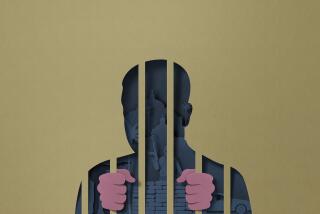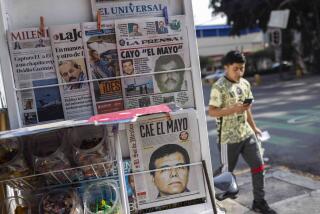Rebels Describe Massacre : Salvadoran âFelt Badlyâ at Shooting Marines at Cafe
SAN SALVADOR â Willian Celio Rivas Bolanos, a baby-faced 17-year-old with a bare trace of a mustache, told reporters Friday that he was one of the guerrillas who shot up a Zona Rosa sidewalk cafe last June, killing 13 people, including four U.S. Marines.
Rivas, one of three suspects in custody for the murders, said that he âfelt badlyâ taking aim at the unarmed men, but gained courage from the leader of the attack.
âI was about six meters from the objective,â Rivas said. âI shot 30 times where the men were. . . . You get nervous, so I donât know if they hit or not.â
The other two suspects arrested in the case said they had known the guerrillas that carried out the attack but that they had not taken part in it themselves. The government has charged the two with providing cover for guerrillas working in the capital.
President Jose Napoleon Duarte announced the arrests of the three earlier this week and said that seven other suspects are still being sought. He added that one of the gunmen, Jose Roberto Salazar Mendoza, was among the 13 killed the night of the shooting.
On Friday, the suspects were presented one at a time for about three hours of questioning by journalists at the officerâs club of the National Guard headquarters. Gerardo Le Chevalier, a government spokesman, stayed at the side of each throughout the questioning, which he said was being allowed to prove the âphysical condition and credibilityâ of the suspects.
The information offered by the three on the Zona Rosa (Pink Zone) attack generally was consistent, except for discrepancies in versions of the sequence of their arrests.
Two of the suspects, Rivas and Juan Miguel Garcia Melendez, admitted to being members of the Central American Revolutionary Workers Party, the group that claimed responsibility for the assault. The third, Jose Abraham Dimas Aguilar, said he had never been a member of the party but that his brother was a member.
Leader Missing
Dimasâ brother, Ismael, was reported to have been the leader of the eight-man group that carried out the attack. His whereabouts are unknown.
Meanwhile, in a communique read over local radio, the party, which is known by its Spanish initials PRTC, asserted that three jailed suspects were not members of the party.
âThey (the government) are lying when they state that they have captured three members of the Mardoquo Cruz Commandos (the partyâs urban guerrilla team),â the communique said. âThe compatriots whom they have accused, captured and tortured are no more than poor victims, and they have served to justify the (U.S.) interventionist escalation in Central America.â
The communique claimed that Rivas was arrested and tortured âeven before the Zona Rosa operation was carried out.â
Fighter at 15
On Friday, Rivas was brought out last by Le Chevalier for questioning. The government spokesman described Rivas as âthe most appetizing desertâ for the reporters. Rivas said he was recruited by the PRTC in embattled San Vicente province and, after attending training camp there, became a combatant at age 15.
He said he took part in a number of battles with government troops in the countryside before party leaders sent him to the city.
Rivas said that here in the capital he had contact with Ismael Dimas Aguilar, whom he had known in the countryside by the pseudonym âUlises.â Rivas said he worked in a party-owned upholstery shop with Garcia, whom he said he loved âlike a brother.â In the capital, Rivas said he had helped to blow up telephone lines, electricity poles, a Coca-Cola truck and national police trucks.
He said that Ulises was his boss in the organization and that Ulises did not inform him of the Zona Rosa operation until four days before it was to be carried out.
Kept on Alert
âHe just said that I had to be alert and ready. He said it was an important act, politically as well as militarily.â
At 5 p.m. on the day of the assault, Rivas was told to be at a drive-in restaurant, where he would be picked up for the attack, four hours later. He said he was told the assault would be on âNorth American advisers.â
When they came for Rivas in a pickup truck, he was given camouflage clothes and an M-16 rifle and told he would be in the âannihilation group.â Ulises led the group, telling him, âWhen I shoot, you start shooting.â
Rivas said they passed a second car that apparently had scouted the Zona Rosa because it honked twice and the pickup honked back.
In the Zona Rosa, Rivas said he took up a position about 18 feet from the tables where the U.S. Marines were seated.
âI saw the men drinking, and I didnât see where they were armed,â Rivas said. âI felt badly firing at people who were unarmed and enjoying their drinks, but Ulises gave me courage.â
Rivas said that no one shot back at the guerrillas.
Rivas said that the day after the massacre, Ulises told him the operation had been âmagnificent.â He said the only problem was that one of their comrades was hurt. They later found out that he died.
Rivas, who several times referred to the army as âthe enemy,â said he wanted to cooperate with officials now because he felt the attack on unarmed men was not right. He also said that he thinks testifying will help his case.
All three suspects said they had not been coerced into confessing, but Dimas later said that he had signed a confession which he did not read and which he thought at the time was âsome papers to get out (of jail) or something about the inventoryâ of his belongings.
Dimas, 30, the father of two, said he was arrested at his auto workshop when officials came to look for his brother, Ismael (Ulises). Dimas said that Ismael and the others sometimes met at his auto shop but that he did not know they had been involved in the Zona Rosa assault until about a week after it occurred.
âI really donât consider that I provided cover for them,â he said.
Government officials have said that Rivas and Dimas were brought in Aug. 12 and that the third suspect, Garcia, was captured at the airport Aug. 16 when he returned after being deported from the United States.
Garcia said that he went to the United States illegally a month after the attack. âI didnât want to pay for something I didnât owe,â he said. âI have never taken anyoneâs life.â
Garcia said he believed he was fingered by Rivas. Rivas, on the other hand, said he believed Garcia was captured first and fingered him. He said that when he was interrogated the first time, the questioner read him testimony, purported to be from Garcia, that included statements âonly he (Garcia) could have known.â
Officials have said that Dimas and Rivas were arrested together, but it became clear in Fridayâs interviews that they were captured in separate operations on the same day.
Since their arrests, the three suspects had previously been seen publicly only in an army-produced videotape shown on television. Rivas also confessed in the videotape, which ended with a voice-over saying, âCase resolved!â
More to Read
Sign up for Essential California
The most important California stories and recommendations in your inbox every morning.
You may occasionally receive promotional content from the Los Angeles Times.










